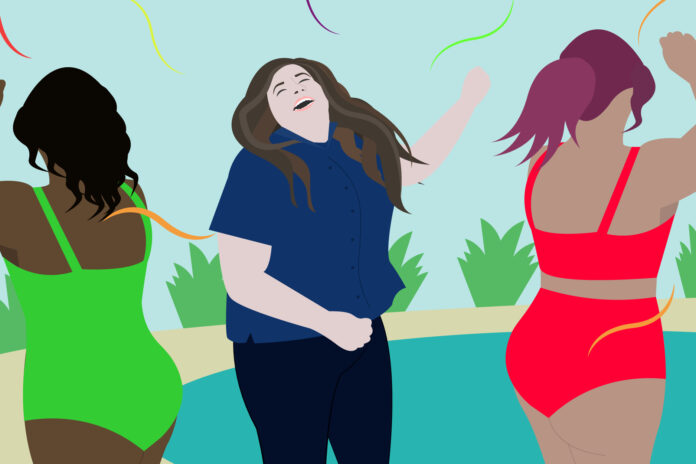Aidy Bryant’s honest, real comedy pulls the heartstrings of viewers
The Hulu original series “Shrill” premiered on March 15 and enchanted viewers with its quirky and unapologetic representation of women. The series is an adaptation of Lindy West’s novel “Shrill: Notes from a Loud Woman” and focuses on a version of West’s younger self. The show is produced by household names Lorne Michaels and Elizabeth Banks. The first season received a score of 91% on Rotten Tomatoes.
“Saturday Night Live” comedian Aidy Bryant stars as the series’ protagonist Annie, a 30-something journalist who happens to be overweight. Throughout the first season of the series, viewers watch Annie develop a sense of self-worth and begin asserting herself in her career and her relationships.
The show has been praised for its body-positive message and realistic depiction of fat women.
“The audience never gets an explanation for Annie’s weight, nor is one necessary to appreciate all the wonderful characteristics that make her a heroine worth rooting for,” said Sarah Conley for CNN. “Instead, ‘Shrill’ shifts the focus to Annie’s relationship with her body and how it impacts her relationship with everyone she encounters — a revolutionary move in today’s culture.”
Annie’s struggles are treated with empathy and normalcy, making her a relatable hero that any viewer will find easy to root for. Bryant’s performance is subtle and nuanced, showing the unspoken troubles fat women everywhere face.
Lolly Adefope stars as Fran, Annie’s best friend and roommate. Fran functions almost as a foil for Annie; while Fran is still a fat woman, she never tries to make herself smaller or apologize for who she is. However, she does not fall under the trope of the funny sidekick that many fat women are casted as either. Fran is a self-possessed and intelligent woman who is also a wonderful friend to Annie. Women lift each other up in this series, and the on-screen relationship between these two characters is a perfect example of it.
“Shrill” has also been praised for its diverse characters and cast. Fran is a black woman who is also a lesbian, and she exists as more than just Annie’s sidekick. She has storylines of her own and is a complex character herself. Characters of all walks of life are featured in the series, each treated with respect and integrity.
In an interview with Vanity Fair, Adefope spoke about what she hopes viewers will take away from the show.
“I hope people see it for what it is, which is just a very interesting story of a woman trying to realize who she is in a world that’s telling her that she shouldn’t be the way she is,” Adefope said. “I hope people see that […] it’s not just a ‘fat show.’ It’s so much more than that. Fat people aren’t just fat people; they have so many layers to them, just like anybody else, that I think should be explored.”
Episode four, titled “Pool,” is the series’ stand-out because it encapsulates the positive message of the show. The episode follows Annie covering a story on the “Fat Babe Pool Party,” a body-acceptance event hosted by the local body-positivity community. Annie knows that she will find a great story if she attends the event, but feels the common anxiety around attending a pool party.
The writer of the episode, Samantha Irby, spoke to Vulture about the anxieties she wanted to highlight in this episode.
“It’s not just about being in a bathing suit and having so little between your body and other people,” Irby said. “It’s being in your bathing suit and also having to project that you’re having a good time.”
The shot of Annie sitting on the side of the pool, fully dressed with her jeans cropped slightly to dangle her legs in the water is powerful. Viewers understand that feeling. Many have sat on the outskirts in the very same way. However, the difference was that Annie and the viewers got to watch a diverse group of women be unapologetic in their suits and actually enjoy themselves.
The scenes at the pool party were beautifully shot and featured a variety of body types. The women laughed, danced and enjoyed the space they occupy in the world.
“I wanted it to feel like the best place you’ve ever been,” Irby said. “Because you don’t get that a lot. You don’t get a lot of beautiful fat spaces.”
Annie does get in the water by the end of the episode, and it feels triumphant. The simple shot of her diving into the pool with a huge smile on her face was heartwarming and memorable.
While the show depicts many uncomfortable scenes of fat-shaming and Annie’s struggles with her body, the character and her plot lines focus on so much more than that. It also follows Annie’s career troubles and pursuit of being a journalist, as well as her complicated relationship with an uptight mother and ill father. At the end of every episode, Annie is a complex and unique character who just so happens to be fat.
“It’s a f—ing mind prison, you know, that every f—ing woman everywhere has been programmed to believe,” Annie rants in one episode. “And I’ve wasted so much time and money and energy, for what? I’m fat. I’m f—ing fat. Hello, I’m fat.”
That is the tone the entire series takes, from the pilot episode to the season finale. The show has recently been picked up for a second season, showing that Annie is fat and here to stay.
Written By: Alyssa Ilsley –– arts@theaggie.org




